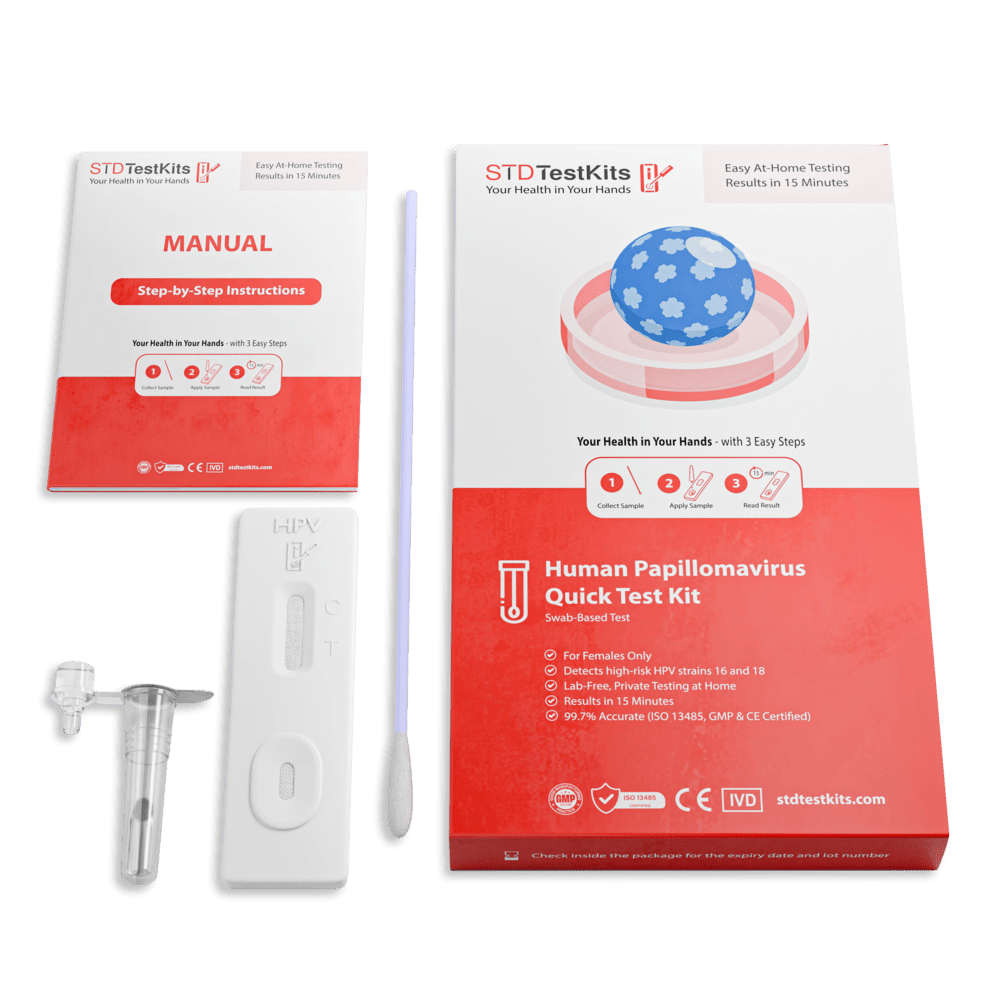Human Papillomavirus (HPV) is the most common STI worldwide, with many strains. Some low-risk types cause genital warts, while high-risk types (notably HPV-16 and HPV-18) can lead to cervical, anal, throat, and penile cancers. Most people get HPV at some point, and it often clears on its own. However, persistent high-risk HPV infections can cause serious cancers if not detected early. HPV usually has no symptoms, so screening is essential.
Our HPV At-Home STD Test Kit is designed for women to detect high-risk HPV-16 and HPV-18. It includes a gentle cervical/vaginal swab for easy, painless self-collection. The rapid test detects HPV DNA with 98% accuracy and delivers results in about 15 minutes. No lab or mailing needed, and the kit ships discreetly for privacy. This test complements regular healthcare by empowering you to monitor your risk between doctor visits.
Symptoms & Complications
Asymptomatic: Most HPV infections cause no visible symptoms. High-risk types do not produce warts but can silently infect cervical cells, often clearing within 1–2 years.
Mild: Low-risk HPV types may cause genital warts, but high-risk types generally cause no symptoms until cell changes appear on a Pap smear.
Severe: Persistent high-risk HPV can cause precancerous lesions and cancers, especially cervical cancer, which develops over years with no early symptoms. Advanced cancer may cause irregular bleeding, pelvic pain, or discharge. HPV can also cause anal, penile, vulvar, vaginal, and throat cancers.
Untreated Risks
Untreated high-risk HPV infections may progress to cancer over 5–15 years. Early detection allows treatment of precancerous changes to prevent cancer. Rarely, HPV can be passed to newborns during birth, causing respiratory papillomatosis. Regular screening is vital to prevent severe outcomes.
Early & Repeat Testing Recommended
Window Period: HPV infections can take 6–12 weeks or longer to be detectable. A negative test does not rule out future infection. Regular screening (e.g., annually) is recommended, especially for sexually active women.
Confirmatory Test: If positive, follow up with a healthcare provider for Pap smear and lab HPV tests to check for cell changes. Continue routine screenings as advised.
Partner Awareness: Men cannot be routinely tested but should be informed if their partner tests positive. Safe sex and vaccination are recommended to reduce transmission risk.
How It Works
Collect Sample: Use the included sterile swab to gently collect cervical/vaginal cells by inserting and rotating the swab. Place it into the provided vial.
Apply & Wait: Process the sample according to instructions, then apply it to the test device and wait about 15 minutes.
Read Results: A control line indicates the test is valid. One line means no high-risk HPV detected. Two lines indicate HPV-16/18 detected. Invalid results require retesting.
Our HPV At-Home STD Test Kit offers a fast, private way to screen for the most dangerous HPV strains. Early detection saves lives by preventing cancer. Take control of your health with this easy, confidential test.



















